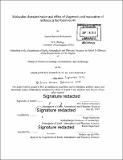| dc.contributor.advisor | Roger Summons. | en_US |
| dc.contributor.author | Herrera Bethencourt, Jorsua(Jorsua G.) | en_US |
| dc.contributor.other | Massachusetts Institute of Technology. Department of Earth, Atmospheric, and Planetary Sciences. | en_US |
| dc.date.accessioned | 2020-02-10T21:40:39Z | |
| dc.date.available | 2020-02-10T21:40:39Z | |
| dc.date.copyright | 2019 | en_US |
| dc.date.issued | 2019 | en_US |
| dc.identifier.uri | https://hdl.handle.net/1721.1/123742 | |
| dc.description | Thesis: S.M. in Geology, Geochemistry and Geobiology, Massachusetts Institute of Technology, Department of Earth, Atmospheric, and Planetary Sciences, 2019 | en_US |
| dc.description | Cataloged from PDF version of thesis. | en_US |
| dc.description | Includes bibliographical references. | en_US |
| dc.description.abstract | Despite the fact that melanin is a ubiquitous pigment found in bacteria, fungi, plants and animals, little is known about its chemical preservation and distribution in the fossil record. Melanins are polymeric phenolic compounds classified into two major groups based in their chemical structures and molecular precursors: eumelanin (dark brown-black in color) and pheomelanin (orange-red in color). Both eumelanin and pheomelanin are complex highly cross-linked biopolymers, being comparable to biomolecules like chitin that are resistant to microbial degradation and diagenetic alteration thereby affording melanins the potential to maintain their integrity for millions of years. Color patterns depend on pigment composition and arrangement. Recent studies have demonstrated that melanin is one of those pigments with the high preservation potential over geologic time scales; it is found in virtually all extant organisms, from bacteria to humans. | en_US |
| dc.description.abstract | For this reason, the analysis of fossil pigments such as melanin may allow inferences about important aspects of the ecology, behavior and evolution of ancient animals. Several studies and techniques have been presented in the last couple of years that have described ways to characterize pigment patterns. These include coupled microscopic and spectroscopic methods, such as Time-of-Flight Secondary Ion Mass Spectrometry (ToF-SIMS), scanning electron microscope (SEM) and synchrotron X-ray techniques, used to examine the morphology and spatial distribution of pigment structures in well-preserved fossil tissues. More recently, mass spectroscopic techniques such as pyrolysis-gas chromatography-mass spectroscopy (Py-GCMS) have been applied, allowing us to determine the composition of melanin fossils through of the identification of its diagenetic products and their processes of chemical preservation. | en_US |
| dc.description.abstract | In this study, we applied Py-GCMS to understand and identify degradation products of melanin from different cephalopod taxa with different maturation histories. Additionally, we analyze fossilized soft-tissue samples from an exceptionally preserved specimen of Borealopelia markmitchelli, a heavily armored herbivorous tetrapod dinosaur, to unveil color patterns and ecology. Our preliminary results improve our understanding of soft tissue preservation and show chemical evidence to support melanin identification, as well to discern chemical features that reflect original color characteristics. | en_US |
| dc.description.statementofresponsibility | by Jorsua Herrera Bethencourt. | en_US |
| dc.format.extent | 59 pages | en_US |
| dc.language.iso | eng | en_US |
| dc.publisher | Massachusetts Institute of Technology | en_US |
| dc.rights | MIT theses are protected by copyright. They may be viewed, downloaded, or printed from this source but further reproduction or distribution in any format is prohibited without written permission. | en_US |
| dc.rights.uri | http://dspace.mit.edu/handle/1721.1/7582 | en_US |
| dc.subject | Earth, Atmospheric, and Planetary Sciences. | en_US |
| dc.title | Molecular characterization and effect of diagenesis and maturation of melanin in the fossil record | en_US |
| dc.type | Thesis | en_US |
| dc.description.degree | S.M. in Geology, Geochemistry and Geobiology | en_US |
| dc.contributor.department | Massachusetts Institute of Technology. Department of Earth, Atmospheric, and Planetary Sciences | en_US |
| dc.identifier.oclc | 1138891649 | en_US |
| dc.description.collection | S.M.inGeology,GeochemistryandGeobiology Massachusetts Institute of Technology, Department of Earth, Atmospheric, and Planetary Sciences | en_US |
| dspace.imported | 2020-02-10T21:40:38Z | en_US |
| mit.thesis.degree | Master | en_US |
| mit.thesis.department | EAPS | en_US |

